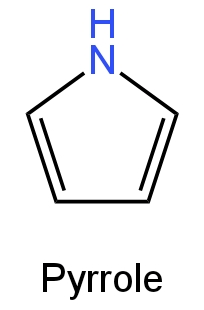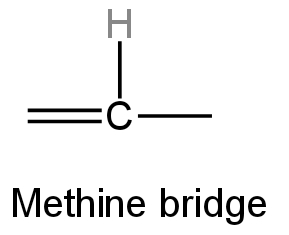
Which of the following metals is present in the green-colored pigment chlorophyll of plants?
A. Fe
B. Mg
C. Na
D. Al
Answer
221.1k+ views
Hint: Chlorophyll is a green pigment present in the chloroplasts of algae and plants.It is one of the significant elements used in the process of photosynthesis. Photosynthesis is the process through which green plants and other organisms utilise sunlight to prepare nutrients from carbon dioxide and water.
Complete Step by Step Solution:
The colour of green plants is due to the chlorophyll pigment. Pyrrole is a five-membered heterocyclic aromatic organic compound containing a nitrogen atom.
The structure of pyrrole is as follows:

Image: Pyrrole
When four pyrrole subunits are connected through methine bridges, they form a union of heterocyclic organic compounds called porphyrins.
Methine is derived from methane and is a trivalent functional group.

Image: Methine bridge
Metal complexes originating from porphyrins are formed naturally.
Heme, a pigment in red blood cells and also a cofactor of the protein haemoglobin, is one type of the porphyrin complex.
Chlorophyll also originates from porphyrin.
In chlorophyll, the four pyrrole units are attached by a central metal atom which is Magnesium.
Here the central magnesium atom is enclosed by a porphyrin ring which is attached to a long carbon-hydrogen side chain called a phytol chain.
So, option B is correct.
Additional Information: The word chlorophyll originates from the Greek word khloros which means green and phyllon which means leaves.
Chlorophyll is a green pigment that works as a photoreceptor in plants.
Note: Chlorophyll has a crucial part in photosynthesis as it enables the plants to absorb energy from the light given by the sun. This energy is later used to carry on the photosynthesis process. Magnesium is an important unit of chlorophyll. Chlorophyll is categorised into five types i.e., chlorophyll a, b, c, d, and d and e.
Complete Step by Step Solution:
The colour of green plants is due to the chlorophyll pigment. Pyrrole is a five-membered heterocyclic aromatic organic compound containing a nitrogen atom.
The structure of pyrrole is as follows:

Image: Pyrrole
When four pyrrole subunits are connected through methine bridges, they form a union of heterocyclic organic compounds called porphyrins.
Methine is derived from methane and is a trivalent functional group.

Image: Methine bridge
Metal complexes originating from porphyrins are formed naturally.
Heme, a pigment in red blood cells and also a cofactor of the protein haemoglobin, is one type of the porphyrin complex.
Chlorophyll also originates from porphyrin.
In chlorophyll, the four pyrrole units are attached by a central metal atom which is Magnesium.
Here the central magnesium atom is enclosed by a porphyrin ring which is attached to a long carbon-hydrogen side chain called a phytol chain.
So, option B is correct.
Additional Information: The word chlorophyll originates from the Greek word khloros which means green and phyllon which means leaves.
Chlorophyll is a green pigment that works as a photoreceptor in plants.
Note: Chlorophyll has a crucial part in photosynthesis as it enables the plants to absorb energy from the light given by the sun. This energy is later used to carry on the photosynthesis process. Magnesium is an important unit of chlorophyll. Chlorophyll is categorised into five types i.e., chlorophyll a, b, c, d, and d and e.
Recently Updated Pages
The hybridization and shape of NH2 ion are a sp2 and class 11 chemistry JEE_Main

What is the pH of 001 M solution of HCl a 1 b 10 c class 11 chemistry JEE_Main

Aromatization of nhexane gives A Benzene B Toluene class 11 chemistry JEE_Main

Show how you will synthesise i 1Phenylethanol from class 11 chemistry JEE_Main

The enolic form of acetone contains a 10sigma bonds class 11 chemistry JEE_Main

Which of the following Compounds does not exhibit tautomerism class 11 chemistry JEE_Main

Trending doubts
JEE Main 2026: Application Form Open, Exam Dates, Syllabus, Eligibility & Question Papers

Derivation of Equation of Trajectory Explained for Students

Hybridisation in Chemistry – Concept, Types & Applications

Understanding the Angle of Deviation in a Prism

How to Convert a Galvanometer into an Ammeter or Voltmeter

Degree of Dissociation: Meaning, Formula, Calculation & Uses

Other Pages
NCERT Solutions For Class 11 Chemistry Chapter 7 Redox Reaction

JEE Advanced Marks vs Ranks 2025: Understanding Category-wise Qualifying Marks and Previous Year Cut-offs

Hydrocarbons Class 11 Chemistry Chapter 9 CBSE Notes - 2025-26

Thermodynamics Class 11 Chemistry Chapter 5 CBSE Notes - 2025-26

NCERT Solutions ForClass 11 Chemistry Chapter Chapter 5 Thermodynamics

Equilibrium Class 11 Chemistry Chapter 6 CBSE Notes - 2025-26




